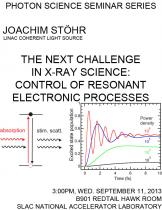Joachim Stöhr, LCLS
My talk will give a historic perspective of the revolutionary science that was enabled by the advent of high power sources of coherent electromagnetic radiation and the implications for future scientific opportunities with x-ray free electron lasers (X-FELs). The historical journey starts with the development of radar microwave sources in the 1940s that fueled the development of nuclear magnetic resonance (NMR) techniques which by now have led to 6 Nobel Prizes. The theoretical description of NMR as coherent processes between nuclear states by Rabi and Bloch also provided the theoretical basis for the optical laser and its applications. Over the last fifty years, many of the 10 Nobel prizes based on lasers are based on unique non-linear interactions of optical light with valence electrons. This unprecedented electronic control is made possible by the large photon degeneracy parameter of lasers in specific modes with many photons simultaneously participating in the interaction process.
These historic developments suggest that another revolution is upon us, based on non-linear x-ray interactions induced by X-FELs. The higher photon energy of such x-ray lasers in conjunction with resonant core-to-valence transitions generates element and chemical state specific information with distinction of charge and spin processes. The high X-FEL degeneracy parameter allows manipulating and controlling the interaction within the femtosecond core hole lifetime through multi-photon stimulated interactions. This capability is completely new and was unavailable during the first 100+ years of x-ray science. I will discuss how to describe non-linear x-ray interactions and at what x-ray fluences they become important. I will also discuss what beam parameters and instrumentation are required to advance this new area of science.





